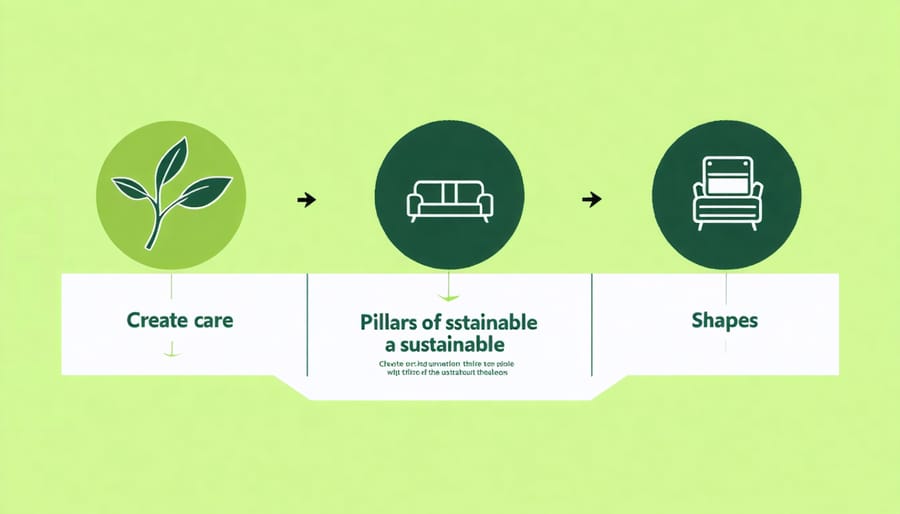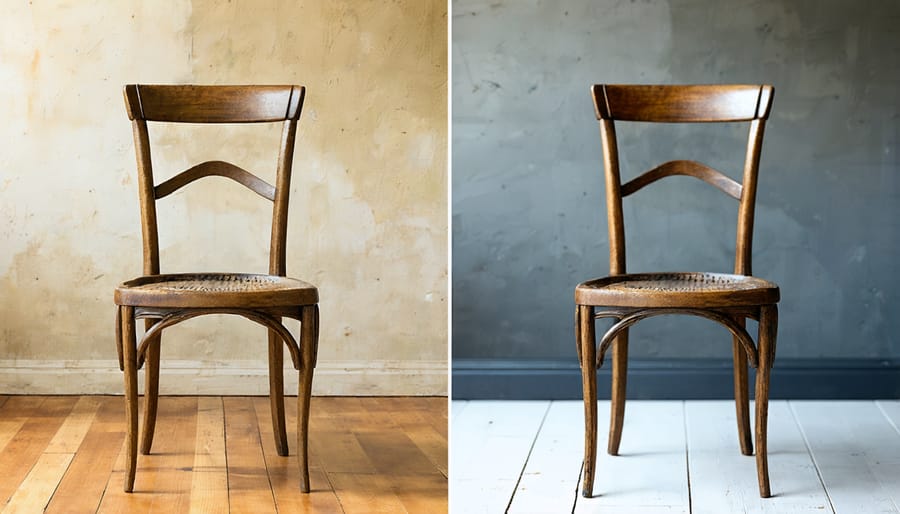The Sustainable Furniture Council stands at the forefront of transforming how we think about, produce, and maintain our furniture in an eco-conscious world. As climate concerns escalate and consumers demand greater environmental responsibility, this organization has emerged as the definitive authority on sustainable furniture practices, certification, and industry standards. Through rigorous assessment protocols and collaborative partnerships with manufacturers, the Council ensures that furniture production meets strict environmental criteria – from responsible material sourcing to energy-efficient manufacturing processes.
Working with over 400 furniture brands and manufacturers globally, the Council’s certification program has become the gold standard for identifying truly sustainable furniture options. Their comprehensive approach considers the entire lifecycle of furniture pieces, from forest to factory to living room, and ultimately, to responsible disposal or recycling. For homeowners and designers alike, their guidelines serve as an essential roadmap for making environmentally responsible furniture choices without compromising on style or quality.
This innovative framework has revolutionized the furniture industry, pushing manufacturers to adopt cleaner production methods, utilize recycled materials, and minimize their carbon footprint – all while meeting the growing consumer demand for sustainable home furnishings.
What Makes Furniture Care Sustainable?
The Three Pillars of Sustainable Furniture Care
Sustainable furniture care rests on three fundamental principles that help preserve both your pieces and our planet. The first pillar, environmental responsibility, focuses on using eco-friendly furniture materials and cleaning products that minimize harmful chemicals and reduce environmental impact. This means choosing natural cleaners and avoiding harsh synthetic products that can damage both your furniture and the ecosystem.
The second pillar, longevity, emphasizes maintaining furniture to extend its lifespan, reducing the need for replacements and keeping items out of landfills. Regular cleaning, prompt repairs, and proper storage all contribute to furniture that lasts generations rather than years.
Resource conservation, the third pillar, focuses on using cleaning supplies efficiently, opting for reusable materials over disposables, and making smart choices about furniture restoration versus replacement. This approach not only saves money but also preserves valuable resources and reduces waste. By embracing these three pillars, you’ll create a maintenance routine that’s good for your furniture, your wallet, and our planet.

Benefits for Your Home and Environment
Choosing and maintaining sustainable furniture brings multiple benefits to both your living space and the environment. By investing in sustainable furniture options, you’re creating a healthier indoor environment free from harmful chemicals and toxins often found in conventional furniture. These pieces typically use natural finishes and materials that improve your home’s air quality while reducing your family’s exposure to synthetic compounds.
Beyond personal benefits, sustainable furniture significantly reduces your environmental footprint. These pieces often incorporate recycled materials, responsibly sourced wood, and eco-friendly manufacturing processes that minimize waste and energy consumption. By choosing sustainably crafted furniture, you’re supporting forest conservation, reducing landfill waste, and helping combat climate change.
Additionally, sustainable furniture tends to be more durable and timeless in design, meaning you’ll replace pieces less frequently. This not only saves you money in the long run but also reduces the environmental impact of furniture production and disposal. The investment in quality, sustainable pieces creates a legacy of responsible consumption that benefits both your home and the planet for generations to come.
Eco-Friendly Cleaning Solutions

Natural Cleaning Recipes
Keeping your sustainable furniture looking its best doesn’t require harsh chemicals. These eco-friendly cleaning solutions are perfect for maintaining your pieces while protecting both your health and the environment.
All-Purpose Wood Cleaner:
Mix 1 cup of white vinegar with 1 cup of water and add 1 tablespoon of olive oil. This gentle solution removes dust and adds shine to wooden surfaces. Apply with a soft microfiber cloth, following the wood grain.
Natural Leather Conditioner:
Combine equal parts white vinegar and linseed oil. Apply sparingly with a clean cloth, working in circular motions. This mixture cleanses while maintaining leather’s natural moisture balance.
Upholstery Freshener:
Sprinkle baking soda over fabric surfaces, let sit for 15-20 minutes, then vacuum thoroughly. For deeper cleaning, mix 1/4 cup vinegar with 3/4 cup warm water and a few drops of essential oil. Test on a hidden area first.
Glass and Metal Polish:
Create a paste using equal parts lemon juice and baking soda. Apply gently to metal hardware or glass elements, then buff with a clean cloth. This natural solution removes tarnish and restores shine without scratching.
Remember to always test these solutions on a small, inconspicuous area first, and never use excessive moisture on wood furniture. These recipes are gentle enough for regular use while maintaining your furniture’s integrity and environmental standards.
Commercial Green Products Worth Your Money
When it comes to caring for your sustainable furniture, choosing the right eco-friendly products makes all the difference. Here’s our carefully curated selection of green cleaning and maintenance products that deliver excellent results while staying true to environmental values.
For wood furniture, we highly recommend Seventh Generation’s Wood Cleaner, which uses plant-based ingredients and essential oils to clean and protect surfaces without harsh chemicals. Another standout is Howard’s Feed-N-Wax, made with beeswax and natural oils, perfect for maintaining and restoring wooden pieces.
For upholstery care, ECOS Furniture Polish & Cleaner offers impressive cleaning power using organic coconut and orange oils. The Earthwash Fabric Care line provides excellent stain removal while being completely biodegradable.
Don’t overlook metal components – Branch Basics All-Purpose Cleaner effectively polishes and protects metal hardware using natural minerals and plant enzymes. For leather furniture, try Pure-Leather’s Eco Conditioner, crafted from organic beeswax and natural oils.
These products not only perform exceptionally well but also come in recyclable packaging and are manufactured by companies committed to sustainable practices. While they might cost slightly more than conventional alternatives, their effectiveness and environmental benefits make them worth the investment. Remember to always test products on a small, hidden area first to ensure compatibility with your furniture.
Preventive Care Techniques
Daily Maintenance Habits
Maintaining your sustainable furniture doesn’t have to be complicated. By establishing simple daily habits, you can extend the life of your pieces while keeping them looking beautiful and reducing their environmental impact.
Start each day by dusting your furniture with a soft, dry microfiber cloth. This prevents dirt buildup and reduces the need for harsh cleaning products later. For wooden pieces, avoid placing hot items directly on surfaces and use coasters to prevent water rings and heat damage.
Position your furniture away from direct sunlight and heat sources to prevent fading and warping. When moving items, always lift rather than drag to protect both the furniture and your flooring. Regular rotation of cushions and pillows helps distribute wear evenly and extends their lifespan.
Keep indoor humidity levels between 30-50% to prevent wood from swelling or shrinking. Use natural cleaning solutions like a mixture of warm water and mild soap for regular cleaning, avoiding chemical-heavy products that can harm both your furniture and the environment.
Address spills immediately with a clean, dry cloth, working from the outside toward the center. These simple daily practices not only preserve your furniture but also support your commitment to sustainable living.
Seasonal Care Guidelines
Proper seasonal care ensures your sustainable furniture remains beautiful while minimizing environmental impact. In spring, gently clean wooden pieces with a damp cloth and natural cleaning solutions, allowing them to dry completely before use. Check for any winter moisture damage and tighten loose joints. For outdoor furniture, apply eco-friendly protective sealants before the rainy season begins.
Summer calls for extra protection against UV damage. Position wooden furniture away from direct sunlight, and use natural fabric covers when pieces aren’t in use. For leather furniture, maintain proper humidity levels to prevent cracking and apply natural conditioning treatments quarterly.
Fall is ideal for deep cleaning and preservation. Clean upholstery with plant-based cleaners, and inspect for wear and tear. For metal pieces, check for rust spots and treat them with non-toxic rust converters. Winter requires special attention to humidity control – use a humidifier to prevent wood from drying and cracking.
Throughout all seasons, rotate cushions regularly, dust weekly with microfiber cloths, and address spills immediately using gentle, eco-friendly cleaning methods. Remember to use sustainable cleaning products and avoid harsh chemicals that can harm both your furniture and the environment. Regular maintenance not only extends furniture life but also reduces the need for replacement, supporting overall sustainability goals.
Restoration vs. Replacement
When to Restore
Deciding whether to restore or replace furniture isn’t always straightforward, but there are clear indicators that can guide your choice. Consider restoration when your piece has good bones – solid construction, quality materials, and sturdy joints. Family heirlooms and antiques, regardless of condition, are typically prime candidates for restoration due to their historical and sentimental value.
Look for signs that the piece is worth saving: hardwood construction, dovetail joints, and original hardware are all positive indicators. Even if the surface is scratched or the finish is worn, these cosmetic issues are usually fixable. Water damage, if caught early, can often be remediated, while minor structural issues like loose joints or small cracks are generally repairable.
However, extensive mold growth, severe structural damage, or widespread insect infestation might signal that replacement is the better option. The key is to evaluate both the emotional and practical value of the piece against the cost and effort of restoration. When in doubt, consult a professional restorer who can provide an expert assessment of the furniture’s restoration potential.
Sustainable Restoration Methods
Embracing sustainable furniture restoration techniques is essential for minimizing environmental impact while preserving cherished pieces. Start by using natural cleaning solutions like vinegar, olive oil, and beeswax instead of harsh chemical cleaners. For repairs, opt for reclaimed wood and non-toxic adhesives that match the original materials. Water-based finishes and low-VOC stains provide beautiful results while protecting indoor air quality.
Consider using plant-based oils like tung or linseed for wood protection, and choose organic fabrics for reupholstery projects. When stripping old finishes, use heat guns or citrus-based removers rather than chemical strippers. Salvage original hardware when possible, and source recycled or sustainably produced replacements when needed.
Remember to properly dispose of any waste materials and recycle what you can. By choosing eco-friendly restoration methods, you’re not just preserving furniture – you’re contributing to a healthier planet while maintaining the integrity of your cherished pieces.

The Role of Professional Certification
Professional certification in sustainable furniture plays a vital role in maintaining industry standards and ensuring environmentally responsible practices. When you’re looking for sustainable furniture or working with professionals in the field, understanding these certifications can help you make informed decisions.
The Sustainable Furniture Council (SFC) leads the way in establishing and maintaining certification standards. Their certification process involves rigorous evaluation of materials, manufacturing processes, and business practices. Companies seeking certification must demonstrate their commitment to environmental stewardship through documented practices and regular audits.
For furniture professionals, certification typically involves completing specialized training programs that cover topics like sustainable materials sourcing, eco-friendly finishing techniques, and responsible waste management. These programs ensure that certified professionals understand both the theoretical and practical aspects of sustainable furniture care.
The certification process also includes ongoing education requirements, keeping professionals updated on the latest sustainable practices and innovations. This continuous learning helps maintain high standards across the industry and ensures that certified professionals can offer the most current environmentally friendly solutions.
For consumers, working with certified professionals offers peace of mind. You can trust that certified furniture care specialists understand how to maintain and restore your furniture using environmentally responsible methods and materials. They’re trained to consider both the longevity of your furniture and its environmental impact.
Whether you’re a furniture care professional seeking certification or a homeowner looking for qualified experts, understanding these professional standards helps ensure that your furniture care choices align with sustainable practices. The certification system serves as a bridge between environmental responsibility and professional expertise, making it easier for everyone to contribute to a more sustainable future.
As we’ve explored throughout this guide, the Sustainable Furniture Council plays a vital role in shaping the future of eco-friendly furniture practices. By following their guidelines and recommendations, we can all contribute to a more sustainable future while enjoying beautiful, long-lasting furniture in our homes.
Remember that sustainable furniture isn’t just about the materials used in manufacturing – it’s about making conscious choices throughout the entire lifecycle of your furniture. From choosing certified sustainable pieces to maintaining them properly and eventually recycling or upcycling them, every decision matters.
You can start making a difference today by implementing small changes in your furniture choices and care routines. Consider purchasing from certified sustainable manufacturers, opt for natural cleaning products, and extend the life of your furniture through proper maintenance. When it’s time to replace pieces, explore recycling options or donate usable items to local charities.
The movement toward sustainable furniture is growing stronger every day, and your participation makes a real impact. Whether you’re furnishing your first apartment or updating your family home, choosing sustainable furniture is an investment in both your living space and our planet’s future.
Let’s commit to making environmentally conscious decisions about our furniture, one piece at a time. Together, we can create beautiful, sustainable homes while protecting our environment for future generations.
